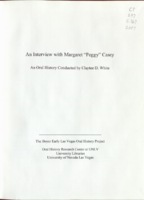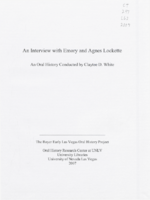Search the Special Collections and Archives Portal
Search Results

Interview with James Nobuo Yamazaki, October 14, 2005
Date
Archival Collection
Description
Text

Interview with John Frederick Campbell, January 14, 2005
Date
Archival Collection
Description
Text

Interview with Bruce Lee Wilhelm, June 22, 2005
Date
Archival Collection
Description
Text

Eric Calvillo interview, June 18, 2019: transcript
Date
Archival Collection
Description
Interviewed by Monserrath Hernández and Laurents Bañuelos-Benitez. Eric Calvillo was born into a Mexican American household in San Jose, California in 1980. As he recalls, it was there that his fixation with the colors and recurring themes of his family's Mexican roots told hold of his imagination. Today, this is core to his growing art career. Art has not been his sole ambition. Before moving to Las Vegas in 2005, Calvillo attended a San Francisco culinary school. He relocated to Las Vegas to complete his culinary internship at the prestigious Picasso restaurant at the Bellagio. Eventually, he began to pursue a professional art career as a painter of Día de los Muertos motifs and beautifully portray the Mexican tradition of celebrating the lives of the deceased. Through his use of acrylics and oil on canvas, Calvillo conveys the emotion of his culture and then, being a skilled carpenter, crafts his own frames.
Text

Interview with James Arnold Hodges, January 17, 2005
Date
Archival Collection
Description
Text

Transcript of interview with Peggy Casey by Claytee D. White, January 13, 2005
Date
Archival Collection
Description
Text

Interview with Henry Eloy Peluaga, April 22, 2005
Date
Archival Collection
Description
Text

Relda W. Leavitt interview, March 18, 1976: transcript
Date
Archival Collection
Description
On March 18, 1976, collector David Steele Broussard interviewed Relda Whitney Leavitt (born April 3rd, 1917 in Saint Thomas, Nevada) at her home in Las Vegas, Nevada. In this interview, Mrs. Leavitt discusses growing up in Saint Thomas, Nevada before her family moved to Las Vegas. She also discusses moving to Las Vegas, Nevada and her family’s dairy business in Whitney, Nevada. She speaks about the different changes and growth she has seen in Las Vegas over the years.
Text

Transcript of interview with Emory and Agnes Lockette by Claytee D. White, March 11, 2005
Date
Archival Collection
Description
Interview with Emory and Agnes Lockette conducted by Claytee D. White on March 11, 2005. The Lockettes were the only African Americans to live in Boulder City during years of racial tension. Agnes taught kindergarten at Westside School, while Emory worked for the Bureau of Reclamation.
Text
Kennedy, Fred "Bud": video interview and transcript, 2005
Level of Description
Archival Collection
Pagination
- Previous page ‹‹
- Page 6
Archival Component
